This is a story of craftsmanship. Effort. Dedication. Persistence. Of Perfection sought.
The title of this movie sounds almost lighthearted, but the substance is deep, profound, in some ways enlightening, but one also feels the weight and the obligation of tradition, family, and duty.
Jiro's story could be read as a tragedy. The details of Jiro's early life are not clear, except for the fact that Jiro was thrust out on his own by the time he was 9 years old, left with no home to return to after his father's business failed. Perhaps this early life was the burned ships that made retreat, indeed, made failure, not an option.
Jiro's work routine is just that - repetition of the same actions again and again, making slight improvements all the time. This repetition, this dedication, discipline, are what have pulled Jiro up, away from his beginnings to the top of his craft, even though he will never say he has reached the top.
His two sons have followed him into the business. The eldest at Jiro's business, the younger at his own. Through the course of the film one sees what was given up by the sons, other ambitions, to pursue the family craft. To pursue and follow the reputation and perhaps the obligation, of Jiro.
Jiro's work and routine is relentless. The repetition and adjustment never stops, yet Jiro describes the act of making sushi as making him feel exuberant. He appears lost in it, absorbed. Dreams of it. One sees the sacrifice necessary for such dedication. Jiro himself recognizes it. There is no discussion of whether the sacrifice and effort is worth it, just that it is what must be done in order to strive to continuously improve.
This viewer is not sure such sacrifice is worth the heights of a craft. However, this viewer has not experienced those heights, the greatest recognition that can be bestowed upon one in the pursuit of a skill. But, Jiro appears to seek only improvement, to only do better. The recognition seems not to be the goal or even a motivation.
Sushi is the form that Jiro's dedication, effort, repetition and persistence has taken. This movie is hardly about fish, shrimp and rice. This movie is about walking a path, about work, about an approach to life, and its consequences.
Sunday, April 08, 2012
Saturday, October 15, 2011
PAX Prime 2011
PAX = Success
I attended this year's PAX Prime not to see any particular game, not to hear any particular speaker or panel, but because it feels great to be in the company of so many like-minded geeks and nerds. PAX's business operations head Robert Khoo confirmed that PAX Prime had approximately 70,000 people this year, making it the largest PAX yet.

Despite the event's size, the founders and organizers remain quite hands-on. I was impressed while waiting in line for the keynote to see Mr. Khoo walking the line, counting attendees so that potential attendees could be told the cutoff for when the venue was going to be full.
Exhibition Halls
The exhibition halls were, as always, impressively large. The place was packed, but the crowds were friendly and people were moving through pretty well, so clogs were rare. The PAX Enforcers are more active every year in managing the lines of people who are waiting to play a demo, have an autograph signed, or get into a panel, and this year was no different.
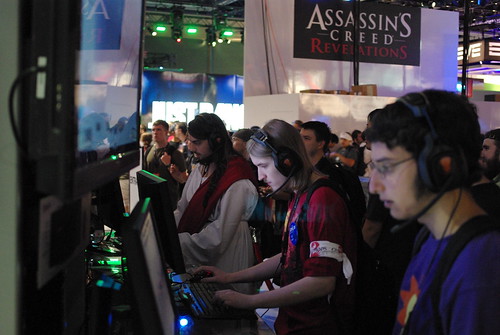
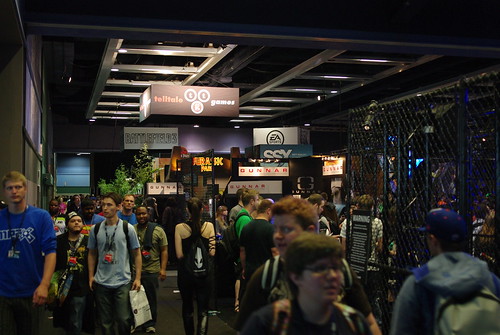
Halofest
Microsoft and Bungie's Halofest was maybe the single most impressive thing I saw at the expo this year. Never have I seen so much Halo gear, games, toys, props and assorted paraphernalia in one place. 2011 was the inaugural year for Halofest, and it did not disappoint. There were life-sized figures from several of the games, but the dioramas of combat scenes were the most impressive.
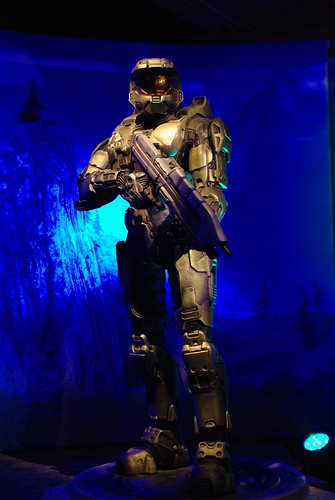
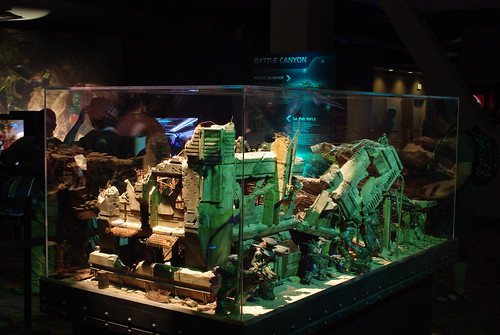

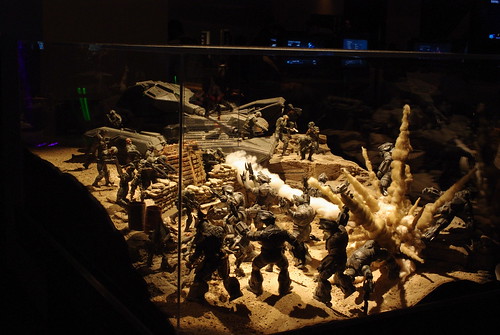
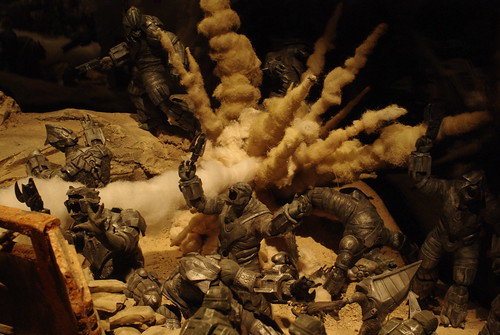
I'm willing to bet it will be at forthcoming PAXes for the foreseeable future, and may even be an independent traveling exhibit in select cities around the country. There is that much stuff, and it is that good.
Indie Games
One of the cooler things I experienced this year was the "indie games" area. There was one smaller exhibition hall dedicated solely to independent developers and games. Unfortunately I did not find this treasure trove until the last day of the show, but I will definitely be returning there at future shows. The neat thing was that the crowds were much less dense in this hall and you had a real opportunity to not only play the games on display, but talk to the developer who made the game.
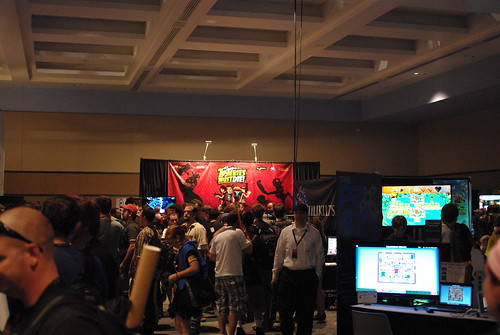
This area also had a zombie makeup booth where you could be "zombified."
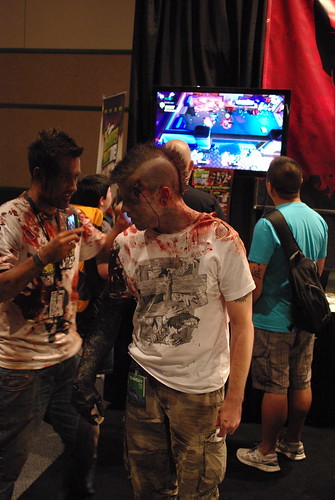
Camaraderie
The people are what keep bringing me back to PAX. We are all so similar there, no matter what type of gaming or geekery we are each interested in. I happened to run into one of the volunteer PAX Enforcers at the airport when I was heading home, and he summed it up well: "No matter how geeky you are, you're not the geekiest one there." Simply put, one feels at ease and among friends. Who wouldn't want that?
All photos are on flickr here.
I attended this year's PAX Prime not to see any particular game, not to hear any particular speaker or panel, but because it feels great to be in the company of so many like-minded geeks and nerds. PAX's business operations head Robert Khoo confirmed that PAX Prime had approximately 70,000 people this year, making it the largest PAX yet.

Despite the event's size, the founders and organizers remain quite hands-on. I was impressed while waiting in line for the keynote to see Mr. Khoo walking the line, counting attendees so that potential attendees could be told the cutoff for when the venue was going to be full.
Exhibition Halls
The exhibition halls were, as always, impressively large. The place was packed, but the crowds were friendly and people were moving through pretty well, so clogs were rare. The PAX Enforcers are more active every year in managing the lines of people who are waiting to play a demo, have an autograph signed, or get into a panel, and this year was no different.


Halofest
Microsoft and Bungie's Halofest was maybe the single most impressive thing I saw at the expo this year. Never have I seen so much Halo gear, games, toys, props and assorted paraphernalia in one place. 2011 was the inaugural year for Halofest, and it did not disappoint. There were life-sized figures from several of the games, but the dioramas of combat scenes were the most impressive.





I'm willing to bet it will be at forthcoming PAXes for the foreseeable future, and may even be an independent traveling exhibit in select cities around the country. There is that much stuff, and it is that good.
Indie Games
One of the cooler things I experienced this year was the "indie games" area. There was one smaller exhibition hall dedicated solely to independent developers and games. Unfortunately I did not find this treasure trove until the last day of the show, but I will definitely be returning there at future shows. The neat thing was that the crowds were much less dense in this hall and you had a real opportunity to not only play the games on display, but talk to the developer who made the game.

This area also had a zombie makeup booth where you could be "zombified."

Camaraderie
The people are what keep bringing me back to PAX. We are all so similar there, no matter what type of gaming or geekery we are each interested in. I happened to run into one of the volunteer PAX Enforcers at the airport when I was heading home, and he summed it up well: "No matter how geeky you are, you're not the geekiest one there." Simply put, one feels at ease and among friends. Who wouldn't want that?
All photos are on flickr here.
Wednesday, July 13, 2011
Buckethead and Picasso, or ...
... a weekend in San Francisco.

Buckethead was the first artist whose work I experienced last weekend. I headed west after work Friday evening and went straight to the Great American Music Hall in San Francisco for a burger and fries before the show.
I have been a Buckethead fan since about 1992 when I became aware of the album Transmutation (Mutatis Mutandis), on which Buckethead plays guitar, and I presume, after seeing this live show, some bass. I'm not sure, but I may have read about that album and Buckethead in a review in one of the guitar magazines at the time, probably Guitar Player.

His performance was pretty awesome. I knew he had amazing skills on the guitar, but to see him pull off all of those sounds live was just incredible.
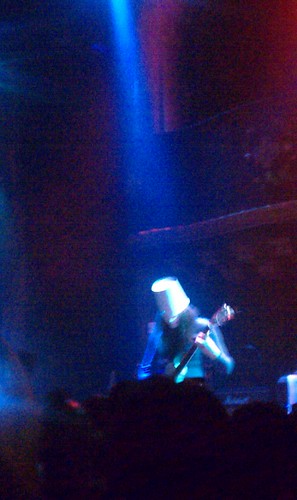
It was just him on the stage, using pre-recorded music. We were all there for his guitar-playing, so that was great. It's hard to describe his music - it's more a collection of themes and emotions rather than your typically structured songs. One minute he's shooting out a high-speed staccato solo and the next he's playing a melodic blues lick.
This was guitar-nerdry at the highest level.
It was an interesting mix of people too. A lot of younger men and women, probably late teens to early twenties, many middle-agers like me, and a few older folks. In addition to guitar, he also played some bass, and I have to believe he picked up some tips from Bootsy Collins (a past collaborator on other projects and legendary bassist for Parliament-Funkadelic), 'cause man, that bucket can play bass! Slappin' and poppin', he can do it all.
He also handed out some toys from a large santa-like sack, took some time out to put down his guitar and do some pop-and-lock dancing and also give a nunchaku demonstration right on stage.
He had a specially modified guitar that let him make and control sounds like I have never heard in a live performance. On his customized white Les Paul he had two "spots," one where the pickup selector switch usually is, and another at the tone knob farthest from the strings, which it appeared he could tap or rub to control effects and maybe a synth to morph his sound.
(Interesting: I just found his signature model here and it describes those "spots" as arcade button-style "kill switches." I really thought they were some sort of electrostatically charged plate that was a controller for some effects device. He must have been working some devices on the floor that I couldn't see.)
Anyway, fantastic show!
The next day, I went to the de Young museum and saw the Picasso exhibit. It was quite a mind-bender. I did not know that Picasso worked in so many media - steel, bronze, charcoal and paper, wood - almost anything in addition to the expected oil or watercolor on canvas. I liked the way he plays with perception, perspective, and the use of simple shapes to convey his subjects. Often his pieces look quite bizarre or child-like. Very much worth the trip if you can make it.

Buckethead was the first artist whose work I experienced last weekend. I headed west after work Friday evening and went straight to the Great American Music Hall in San Francisco for a burger and fries before the show.
I have been a Buckethead fan since about 1992 when I became aware of the album Transmutation (Mutatis Mutandis), on which Buckethead plays guitar, and I presume, after seeing this live show, some bass. I'm not sure, but I may have read about that album and Buckethead in a review in one of the guitar magazines at the time, probably Guitar Player.

His performance was pretty awesome. I knew he had amazing skills on the guitar, but to see him pull off all of those sounds live was just incredible.

It was just him on the stage, using pre-recorded music. We were all there for his guitar-playing, so that was great. It's hard to describe his music - it's more a collection of themes and emotions rather than your typically structured songs. One minute he's shooting out a high-speed staccato solo and the next he's playing a melodic blues lick.
This was guitar-nerdry at the highest level.
It was an interesting mix of people too. A lot of younger men and women, probably late teens to early twenties, many middle-agers like me, and a few older folks. In addition to guitar, he also played some bass, and I have to believe he picked up some tips from Bootsy Collins (a past collaborator on other projects and legendary bassist for Parliament-Funkadelic), 'cause man, that bucket can play bass! Slappin' and poppin', he can do it all.
He also handed out some toys from a large santa-like sack, took some time out to put down his guitar and do some pop-and-lock dancing and also give a nunchaku demonstration right on stage.
He had a specially modified guitar that let him make and control sounds like I have never heard in a live performance. On his customized white Les Paul he had two "spots," one where the pickup selector switch usually is, and another at the tone knob farthest from the strings, which it appeared he could tap or rub to control effects and maybe a synth to morph his sound.
(Interesting: I just found his signature model here and it describes those "spots" as arcade button-style "kill switches." I really thought they were some sort of electrostatically charged plate that was a controller for some effects device. He must have been working some devices on the floor that I couldn't see.)
Anyway, fantastic show!
The next day, I went to the de Young museum and saw the Picasso exhibit. It was quite a mind-bender. I did not know that Picasso worked in so many media - steel, bronze, charcoal and paper, wood - almost anything in addition to the expected oil or watercolor on canvas. I liked the way he plays with perception, perspective, and the use of simple shapes to convey his subjects. Often his pieces look quite bizarre or child-like. Very much worth the trip if you can make it.
Friday, June 17, 2011
Howard Stern makes national news with Weiner press conference
I heard a story on NPR this morning about a heckler at Anthony Weiner's resignation press conference yesterday. I figured the heckler was Benjy Bronk, one of Stern's writers, because Benjy had disrupted one of Weiner's previous press conferences, which had been discussed on the show this week. Indeed, the linked story mentions Benjy by name. The radio report only said he was a writer for "shock jock" Howard Stern.
It's so great that the national news media had to mention Stern's name, although NPR felt obligated to qualify the mere mention with the term "shock jock." Such an outdated term, and not even accurate.
Thursday, December 09, 2010
Howard Stern re-signs with SiriusXM
Awesome. Now I'll be able to make it through my commute for five more years. Consider my subscription renewed.
For anyone who heard yesterday's show, you know we now can look forward to seeing George Takei wrestling with Ralph Cirella and Richard Christy in speedos!
For anyone who heard yesterday's show, you know we now can look forward to seeing George Takei wrestling with Ralph Cirella and Richard Christy in speedos!
Thursday, November 11, 2010
Call of Duty: Black Ops - first impressions
The major difference between this game and the new Medal of Honor is the narrative presentation. Medal of Honor is fairly straightforward, gritty even, allowing you to play different aspects of one single mission within a much larger war. Also, with Medal of Honor, while there is an ultimate mission goal, it is clear your allegiance as a character is to your fellow soldiers rather than to being a "save the world" hero. You feel closer to the action.
COD: Black Ops has different ambitions, as one might expect from this series. As you can tell from the title of the game, you play as an operative on secret, behind-the-scenes missions. The setting for this game is the Cold War - the game begins in 1961 and I believe you play through several real-world conflicts, starting with the Bay of Pigs. I'm only a couple of missions in, so I don't know how far through history this game goes.
I like the type of game that fills in the holes of history. Games that allow you to play through a story that is framed by actual historical events. This is that type of game. So far, the story is pretty fantastical, but still fun. I have only played the single player campaign, and so far, I like it.
The graphics are sharp, controls are responsive, and the sound is good. I noticed a few times where the action paused for a second while the game was loading, but hopefully that will be minimized or eliminated by installing the game on the hard drive. This game feels highly polished, and I'm looking forward to finishing it and playing the multiplayer and co-op zombie modes.
COD: Black Ops has different ambitions, as one might expect from this series. As you can tell from the title of the game, you play as an operative on secret, behind-the-scenes missions. The setting for this game is the Cold War - the game begins in 1961 and I believe you play through several real-world conflicts, starting with the Bay of Pigs. I'm only a couple of missions in, so I don't know how far through history this game goes.
I like the type of game that fills in the holes of history. Games that allow you to play through a story that is framed by actual historical events. This is that type of game. So far, the story is pretty fantastical, but still fun. I have only played the single player campaign, and so far, I like it.
The graphics are sharp, controls are responsive, and the sound is good. I noticed a few times where the action paused for a second while the game was loading, but hopefully that will be minimized or eliminated by installing the game on the hard drive. This game feels highly polished, and I'm looking forward to finishing it and playing the multiplayer and co-op zombie modes.
Saturday, October 23, 2010
Medal of Honor - full review
My initial impressions are here. The main issue I had early on in playing the Medal of Honor [wiki entry - plot spoilers there] campaign was distracting audio dropouts during heavy onscreen activity, specifically when my character was firing the PKM machine gun. I'm happy to report I had no further incidents of such dropouts during the remainder of the campaign.
The only other sort of glitch I noticed is that I was able to run up onto a spawn point for the enemies in one of the later levels. I think it was in the "Rescue the Rescuers" level where you are advancing up a rocky mountain. I don't know if I moved forward too fast or just went an unexpected direction, but me and my squad were all sitting around this spawn point just killing enemies as they appeared. It took me a few seconds to realize what was happening and how these guys seemed to be getting the jump on us so quickly.
The overall narrative of the campaign is quite good, and pretty different from most games of this genre. The focus is on the soldiers and their loyalty to each other, not some overarching mega-mission to save the world. You play a number of different types of special operations soldiers, including Army Rangers, Delta Force and Tier 1 operatives, each at different points and from different points of view of the same overall sequence of events.
My favorite game mechanic is the slide - as you run to cover, if you crouch while you're running you will go into a slide and stop against the cover and end up in a crouched position, ready to go. It's really too bad this mechanic did not carry over to the multiplayer aspect of the game. The slide is a great addition that I haven't seen before, and the mechanic is executed flawlessly, much like Rainbow Six: Vegas 2's implementation of anchoring behind cover and rotating out or above to shoot (see here at about the 33 second mark).
The campaign is quite short, maybe four to six hours, depending on your skill and aggressiveness. I wish it had been longer, but what is there is good. There is a good variety of vehicle and weapon usage. The gameplay is fairly structured, however, and while you are definitely not playing "on rails," the game takes you where you need to go, providing the appropriate weapon for the situation. Also, as I have seen others mention, there are areas in the game with "invisible walls" where you can see an area your character could obviously go to, but the game simply won't let you. This sort of funnels you through some parts of the game, and while it is a small complaint and something I only noticed once or twice, it would be just that more immersive if your character could explore any area that appears accessible.
Multiplayer
The multiplayer felt good, other than the fact that the controls did not directly carry over from the single player campaign. For one, the slide mechanic is missing, and the other thing is that your controller settings have to be set separately. For many games I don't use the default controller configuration and I had to set that configuration up in the multiplayer separately even though I had already done so for the single player campaign. Also, the configurations are named differently between the single and multiplayer, so it's not immediately apparent which in the multiplayer will be the same as what you use in single player. This is fairly small, easily remedied and hopefully a one-time thing, but I spent 10-15 seconds in my first live multiplayer map sitting vulnerable while I configured my controller.
There do not appear to be a lot of options to select the type of game you want to play in multiplayer. Admittedly, I have not played a ton of games, so maybe I just haven't found all of the options, but it looks like you select a "type" of game (combat mission, team assault, objective raid, sector control or hardcore) and go. That's fine with me, but I imagine for the multiplayer junkies out there who like specific settings, it may not be enough.
Comparisons to Battlefield Bad Company 2's multiplayer are inevitable as the same developer did the multiplayer for this game. The feel is similar, but the settings and goals in the various gametypes are different enough that I was not constantly being reminded of BFBC2. This multiplayer stands on its own. Now I just need to get some of my friends online to play with me.
Overall
I definitely give this one a "thumbs-up." The only hesitation I have in a full "buy" recommendation is that you should probably make sure your friends online are also going to buy this one since the single player campaign is so short. The campaign looks to have decent replayability with multiple levels of difficulty and a "Tier 1" mode (available after completing the game once) which involves beating each stage under a "par" time, but once that's done you'll be playing with random people online if your friends don't have the game.
The only other sort of glitch I noticed is that I was able to run up onto a spawn point for the enemies in one of the later levels. I think it was in the "Rescue the Rescuers" level where you are advancing up a rocky mountain. I don't know if I moved forward too fast or just went an unexpected direction, but me and my squad were all sitting around this spawn point just killing enemies as they appeared. It took me a few seconds to realize what was happening and how these guys seemed to be getting the jump on us so quickly.
The overall narrative of the campaign is quite good, and pretty different from most games of this genre. The focus is on the soldiers and their loyalty to each other, not some overarching mega-mission to save the world. You play a number of different types of special operations soldiers, including Army Rangers, Delta Force and Tier 1 operatives, each at different points and from different points of view of the same overall sequence of events.
My favorite game mechanic is the slide - as you run to cover, if you crouch while you're running you will go into a slide and stop against the cover and end up in a crouched position, ready to go. It's really too bad this mechanic did not carry over to the multiplayer aspect of the game. The slide is a great addition that I haven't seen before, and the mechanic is executed flawlessly, much like Rainbow Six: Vegas 2's implementation of anchoring behind cover and rotating out or above to shoot (see here at about the 33 second mark).
The campaign is quite short, maybe four to six hours, depending on your skill and aggressiveness. I wish it had been longer, but what is there is good. There is a good variety of vehicle and weapon usage. The gameplay is fairly structured, however, and while you are definitely not playing "on rails," the game takes you where you need to go, providing the appropriate weapon for the situation. Also, as I have seen others mention, there are areas in the game with "invisible walls" where you can see an area your character could obviously go to, but the game simply won't let you. This sort of funnels you through some parts of the game, and while it is a small complaint and something I only noticed once or twice, it would be just that more immersive if your character could explore any area that appears accessible.
Multiplayer
The multiplayer felt good, other than the fact that the controls did not directly carry over from the single player campaign. For one, the slide mechanic is missing, and the other thing is that your controller settings have to be set separately. For many games I don't use the default controller configuration and I had to set that configuration up in the multiplayer separately even though I had already done so for the single player campaign. Also, the configurations are named differently between the single and multiplayer, so it's not immediately apparent which in the multiplayer will be the same as what you use in single player. This is fairly small, easily remedied and hopefully a one-time thing, but I spent 10-15 seconds in my first live multiplayer map sitting vulnerable while I configured my controller.
There do not appear to be a lot of options to select the type of game you want to play in multiplayer. Admittedly, I have not played a ton of games, so maybe I just haven't found all of the options, but it looks like you select a "type" of game (combat mission, team assault, objective raid, sector control or hardcore) and go. That's fine with me, but I imagine for the multiplayer junkies out there who like specific settings, it may not be enough.
Comparisons to Battlefield Bad Company 2's multiplayer are inevitable as the same developer did the multiplayer for this game. The feel is similar, but the settings and goals in the various gametypes are different enough that I was not constantly being reminded of BFBC2. This multiplayer stands on its own. Now I just need to get some of my friends online to play with me.
Overall
I definitely give this one a "thumbs-up." The only hesitation I have in a full "buy" recommendation is that you should probably make sure your friends online are also going to buy this one since the single player campaign is so short. The campaign looks to have decent replayability with multiple levels of difficulty and a "Tier 1" mode (available after completing the game once) which involves beating each stage under a "par" time, but once that's done you'll be playing with random people online if your friends don't have the game.
Subscribe to:
Posts (Atom)




